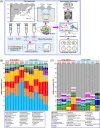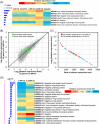Early stage of biofilm assembly on microplastics is structured by substrate size and bacterial motility
- PMID: 38867926
- PMCID: PMC10989967
- DOI: 10.1002/imt2.121
Early stage of biofilm assembly on microplastics is structured by substrate size and bacterial motility
Abstract
The taxonomic structure of biofilms on 0.3-mm microplastics differed significantly from that on 3-mm microplastics or glass particles. Compared with the 3-mm microplastics, biofilms on 0.3-mm microplastics were enriched for genes involved in flagellar-based motility and chemotaxis, pointing to a more 'mobile' community. The association between motility and bacterial colonization of 0.3-mm microplastics was observed through laboratory experiments using isolated strains.
© 2023 The Authors. iMeta published by John Wiley & Sons Australia, Ltd on behalf of iMeta Science.
Conflict of interest statement
The authors declare no conflict of interest.
Figures



Similar articles
-
New insight into the effect of microplastics on antibiotic resistance and bacterial community of biofilm.Chemosphere. 2023 Sep;335:139151. doi: 10.1016/j.chemosphere.2023.139151. Epub 2023 Jun 6. Chemosphere. 2023. PMID: 37290506
-
Biofilm of petroleum-based and bio-based microplastics in seawater in response to Zn(II): Biofilm formation, community structure, and microbial function.Sci Total Environ. 2024 Jun 10;928:172397. doi: 10.1016/j.scitotenv.2024.172397. Epub 2024 Apr 10. Sci Total Environ. 2024. PMID: 38608889
-
Inactivation of the core cheVAWY chemotaxis genes disrupts chemotactic motility and organised biofilm formation in Campylobacter jejuni.FEMS Microbiol Lett. 2020 Jan 15;367(24):fnaa198. doi: 10.1093/femsle/fnaa198. FEMS Microbiol Lett. 2020. PMID: 33264398
-
Colonization characteristics and surface effects of microplastic biofilms: Implications for environmental behavior of typical pollutants.Sci Total Environ. 2024 Aug 10;937:173141. doi: 10.1016/j.scitotenv.2024.173141. Epub 2024 May 16. Sci Total Environ. 2024. PMID: 38761927 Review.
-
Motility of Vibrio spp.: regulation and controlling strategies.Appl Microbiol Biotechnol. 2020 Oct;104(19):8187-8208. doi: 10.1007/s00253-020-10794-7. Epub 2020 Aug 20. Appl Microbiol Biotechnol. 2020. PMID: 32816086 Review.
Cited by
-
A bacterial symbiont in the gill of the marine scallop Argopecten irradians irradians metabolizes dimethylsulfoniopropionate.mLife. 2023 Jun 26;2(2):178-189. doi: 10.1002/mlf2.12072. eCollection 2023 Jun. mLife. 2023. PMID: 38817626 Free PMC article.
-
Bioprospecting of culturable marine biofilm bacteria for novel antimicrobial peptides.Imeta. 2024 Oct 17;3(6):e244. doi: 10.1002/imt2.244. eCollection 2024 Dec. Imeta. 2024. PMID: 39742298 Free PMC article.
-
Branched-chain amino acid metabolism supports Roseobacteraceae positive interactions in marine biofilms.Appl Environ Microbiol. 2025 Mar 19;91(3):e0241124. doi: 10.1128/aem.02411-24. Epub 2025 Feb 11. Appl Environ Microbiol. 2025. PMID: 39932299 Free PMC article.
-
Acute Ammonia Causes Pathogenic Dysbiosis of Shrimp Gut Biofilms.Int J Mol Sci. 2024 Feb 23;25(5):2614. doi: 10.3390/ijms25052614. Int J Mol Sci. 2024. PMID: 38473861 Free PMC article.
-
Genomic Analysis of Novel Sulfitobacter Bacterial Strains Isolated from Marine Biofilms.Mar Drugs. 2024 Jun 22;22(7):289. doi: 10.3390/md22070289. Mar Drugs. 2024. PMID: 39057398 Free PMC article.
References
-
- Hale, Robert C. , Seeley Meredith E., Guardia Mark J. L., Mai Lei, and Zeng Eddy Y.. 2020. “A Global Perspective on Microplastics.” Journal of Geophysical Research: Oceans 125: e2018JC014719. 10.1029/2018JC014719 - DOI
-
- Teuten, Emma L. , Saquing Jovita M., Knappe Detlef R. U., Barlaz Morton A., Jonsson Susanne, Björn Annika, Rowland Steven J., et al. 2009. “Transport and Release of Chemicals from Plastics to the Environment and to Wildlife.” Philosophical Transactions of the Royal Society B: Biological Sciences 364: 2027–45. 10.1098/rstb.2008.0284 - DOI - PMC - PubMed
-
- Suaria, Giuseppe , Avio Carlo G., Mineo Annabella, Lattin Gwendolyn L., Magaldi Marcello G., Belmonte Genuario, Moore Charles J., Regoli Francesco, and Aliani Stefano. 2016. “The Mediterranean Plastic Soup: Synthetic Polymers in Mediterranean Surface Waters.” Scientific Reports 6: 37551. 10.1038/srep37551 - DOI - PMC - PubMed
LinkOut - more resources
Full Text Sources
